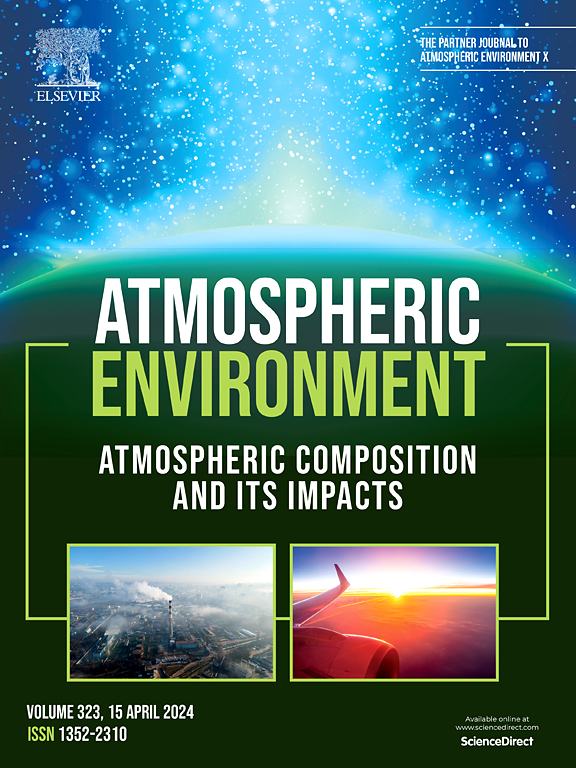Chemical and toxicological characteristics of fine particles from festive fireworks in urban residential communities
IF 4.2
2区 环境科学与生态学
Q2 ENVIRONMENTAL SCIENCES
引用次数: 0
Abstract
In urban areas of low-and middle-income countries, short-term anthropogenic activities, such as festive fireworks, escalate air pollution. Diwali, one of the major Indian festivals, leads to severe air quality conditions due to massive emissions from fireworks. While the mass concentrations in ambient fixed locations are well explored, the chemical characterization and the redox-active components during such events, as well as potential exposures in residential outdoor locations, are poorly studied. This study focuses on examining the diurnal variation of fine particulate matter (PM2.5) and its chemical and toxicological properties in residential areas during festive fireworks. A 5-day continuous diurnal monitoring was conducted across different residential sites in Mumbai, India, using real-time PM sensors collocated with the gravimetric measurements. The collected particles were subjected to multiple optical (babs,370 and babs,880), chemical (ionic, water-soluble organic carbon, elemental), and oxidative potential (OPDTT and OPAA) analyses. The study shows that the average increase in residential outdoor PM2.5 concentration on Diwali night was ∼2.6 times higher than on non-Diwali night (206 ± 167 μg/m3). Similarly, optical parameters (babs,370 and babs,880) are elevated by 1.5 times, ions such as K+, NH4+, NO3−, and SO42− by 5 times while Zn, Pb, Mn, and Cu spiked by ∼ 3 times during Diwali night. Toxicity of the particles as estimated by OPDTTv and OPAAv, increased by ∼1.5-fold during Diwali night, and was significantly correlated with NO3−, SO42−, Mn, Ni, and As (p < 0.05). Chemical speciation data reveal that toxic pollutants from Diwali fireworks increase particle toxicity. This study highlights the need for strict regulation of fireworks and policies addressing acute emission events. To protect public health, long-term air quality management strategies are essential in urban areas of India, rather than just short-term bans on fireworks or other episodic events.

城市居民社区节日烟花细颗粒物的化学和毒理学特征
在低收入和中等收入国家的城市地区,节日烟花等短期人为活动加剧了空气污染。排灯节是印度的主要节日之一,由于烟花的大量排放导致空气质量严重恶化。虽然对环境固定地点的质量浓度进行了很好的探索,但对这些事件中的化学特征和氧化还原活性成分以及住宅室外场所的潜在暴露研究甚少。本研究的重点是研究节日烟花期间居民区细颗粒物(PM2.5)的日变化及其化学和毒理学特性。在印度孟买的不同居民区进行了为期5天的连续昼夜监测,使用实时PM传感器与重力测量相结合。收集到的颗粒进行了多种光学(babs,370和babs,880)、化学(离子、水溶性有机碳、元素)和氧化电位(OPDTT和OPAA)分析。研究表明,排灯节夜间居民室外PM2.5浓度的平均增幅为非排灯节夜间的约2.6倍(206±167 μg/m3)。同样,在排灯节夜间,光学参数(babs,370和babs,880)增加了1.5倍,离子(如K+, NH4+, NO3−和SO42−)增加了5倍,而Zn, Pb, Mn和Cu增加了约3倍。根据OPDTTv和OPAAv估计,颗粒的毒性在排灯节夜间增加了~ 1.5倍,并且与NO3−,SO42−,Mn, Ni和as显著相关(p <;0.05)。化学形态数据显示,排灯节烟花产生的有毒污染物会增加颗粒物的毒性。这项研究强调了对烟花爆竹进行严格监管和制定政策解决急性排放事件的必要性。为了保护公众健康,印度城市地区的长期空气质量管理战略至关重要,而不仅仅是短期禁止烟花爆竹或其他偶发事件。
本文章由计算机程序翻译,如有差异,请以英文原文为准。
求助全文
约1分钟内获得全文
求助全文
来源期刊

Atmospheric Environment
环境科学-环境科学
CiteScore
9.40
自引率
8.00%
发文量
458
审稿时长
53 days
期刊介绍:
Atmospheric Environment has an open access mirror journal Atmospheric Environment: X, sharing the same aims and scope, editorial team, submission system and rigorous peer review.
Atmospheric Environment is the international journal for scientists in different disciplines related to atmospheric composition and its impacts. The journal publishes scientific articles with atmospheric relevance of emissions and depositions of gaseous and particulate compounds, chemical processes and physical effects in the atmosphere, as well as impacts of the changing atmospheric composition on human health, air quality, climate change, and ecosystems.
 求助内容:
求助内容: 应助结果提醒方式:
应助结果提醒方式:


